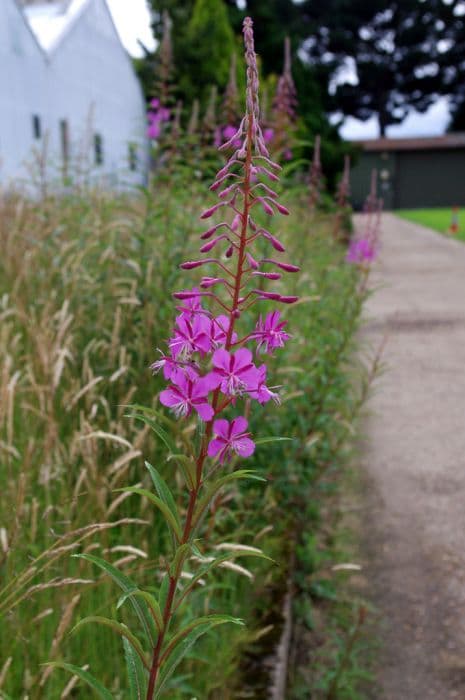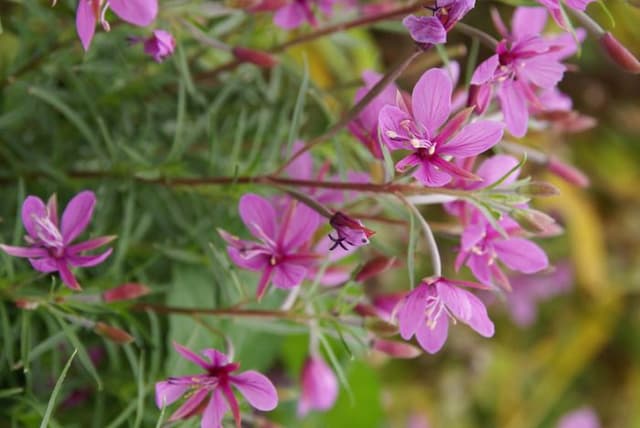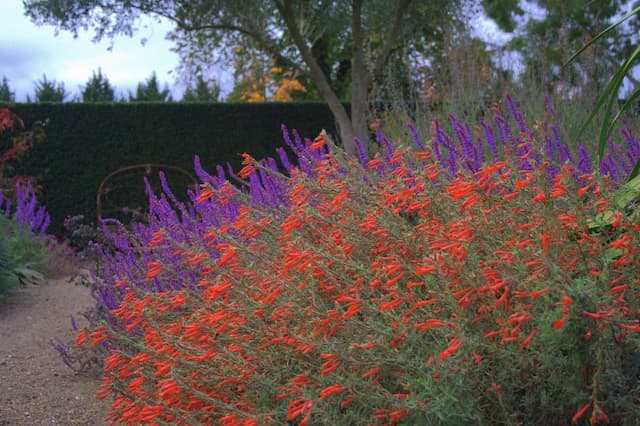White Gaura Oenothera lindheimeri 'Little Janie' (G)

ABOUT
Oenothera lindheimeri 'Little Janie', commonly known as Gaura, is a flowering perennial that boasts a delicate and airy appearance. Its most striking features are the slender, erect stems which bear a profusion of dainty flowers. The blooms of the Gaura possess a certain whimsy: they are typically white but can have a touch of blush pink, often with a butterfly-like shape that is accentuated by the plant's tendency to sway in the breeze. The foliage of Gaura 'Little Janie' serves as a gentle backdrop to the flowers, with narrow leaves that are lance-shaped and sometimes exhibit a touch of red or burgundy, particularly along the leaf margins. Throughout the blooming season, the plant maintains a visual lightness, creating an effect similar to a cloud of small butterflies taking flight. This variety of Gaura has a tidy growth habit, with the stems and leaves forming a loose and open shape that is appealing in a garden setting. The longevity of the Gaura 'Little Janie' flowers also contributes to the plant's ornamental value, as they tend to blossom over an extended period, providing interest for much of the warmer months. This extended flowering period means a continuous display of its whimsical blooms, adding movement and life to the garden almost as if the air around it were filled with fluttering butterflies.
About this plant
 Names
NamesFamily
Onagraceae.
Synonyms
Butterfly Gaura, Whirling Butterflies, Wand Flower, White Gaura, Lindheimer's Beeblossom.
Common names
Gaura lindheimeri 'Little Janie', Oenothera lindheimeri.
 Toxicity
ToxicityTo humans
The Gaura, Oenothera lindheimeri 'Little Janie', is not known to be toxic to humans. There are no significant symptoms of poisoning associated with this plant, as it is not considered poisonous. Therefore, ingesting parts of this Gaura should not result in toxicity and related consequences.
To pets
The Gaura, Oenothera lindheimeri 'Little Janie', is also not known to be toxic to pets. It does not cause any significant symptoms of poisoning in animals such as dogs and cats, and there should be no toxic consequences from pets ingesting parts of this plant.
 Characteristics
CharacteristicsLife cycle
Perennials
Foliage type
Deciduous
Color of leaves
Green
Flower color
White
Height
1 feet 4 inches (40 cm)
Spread
1 feet 4 inches (40 cm)
Plant type
Herb
Hardiness zones
6
Native area
North America
Benefits
 General Benefits
General Benefits- Drought Tolerance: Once established, Pink Evening Primrose is highly tolerant to drought, needing minimal supplemental water, which makes it an ideal choice for xeriscaping and low-water gardens.
- Low Maintenance: This species requires little care once established, making it suitable for gardeners of all skill levels.
- Attracts Pollinators: Pink Evening Primrose is known to attract butterflies, bees, and other beneficial pollinators, which can help enhance the overall health and productivity of the garden.
- Long Blooming Season: Pink Evening Primrose boasts a long blooming period from spring to fall, providing extended visual interest in the landscape.
- Heat Tolerance: It performs well in hot climates, making it a good option for gardens in warmer zones.
- Deer Resistance: This plant is generally resistant to deer, which is an advantage in areas where deer browsing is a problem for gardeners.
- Soil Adaptability: It can adapt to a variety of soil types, though it prefers well-draining soils.
- Landscape Versatility: Pink Evening Primrose can be used in a variety of garden settings such as borders, rock gardens, and container plantings due to its compact size and attractive flowers.
- Erosion Control: The plant's root system can help stabilize soil, making it beneficial for sloping areas where erosion might be a concern.
- Aesthetic Appeal: With its delicate pink flowers and fine, grassy foliage, Pink Evening Primrose adds a splash of color and texture to garden beds and landscapes.
 Medical Properties
Medical PropertiesThis plant is not used for medical purposes.
 Air-purifying Qualities
Air-purifying QualitiesThis plant is not specifically known for air purifying qualities.
 Other Uses
Other Uses- Oenothera lindheimeri 'Little Janie', commonly known as Gaura, can be used in cut flower arrangements, adding an airy and whimsical touch to bouquets with its delicate flowers on long, slender stems.
- Gaura is often planted in butterfly gardens as it is known to attract a variety of butterflies and other pollinators, which can help to support local ecosystems.
- The plant can serve as an interesting addition to sensory gardens due to its unique texture and movement in the breeze, providing a stimulating experience for both sight and touch.
- Gaura can be used in xeriscaping, a landscaping style that reduces the need for irrigation, as it is tolerant of drought and thrives in well-drained soils.
- The Gaura plant is suitable for erosion control on slopes or banks because its root system helps to stabilize the soil and prevent runoff.
- It can be incorporated into moon gardens, which are designed to be enjoyed at night, as the white variety of Gaura reflects moonlight, creating a glowing effect.
- Dried seed heads of Gaura can be used in dried floral arrangements or as part of craft projects for their interesting shapes and textures.
- In educational gardens, Gaura can be used to teach about the lifecycle of plants and the importance of pollinators in the ecosystem due to its attractant qualities.
- The plant can be used in a naturalistic or prairie-style garden design, mimicking the wild habitats where Gaura is commonly found and contributing to a meadow-like aesthetic.
- Gaura's long blooming period makes it an excellent choice for adding long-lasting color to container gardens, either as a focal point or a companion plant.
Interesting Facts
 Feng Shui
Feng ShuiThe Gaura is not used in Feng Shui practice.
 Zodiac Sign Compitability
Zodiac Sign CompitabilityThe Gaura is not used in astrology practice.
 Plant Symbolism
Plant Symbolism- Femininity - The Oenothera lindheimeri 'Little Janie', commonly known as Gaura, is often associated with femininity due to its delicate and graceful appearance.
- Whimsy - The Gaura's soft, whimsical flowers that seem to dance on the breeze bring a sense of playfulness and light-heartedness to any garden space.
- Purity - The white blooms of the Gaura can symbolize purity and innocence, echoing its clean and elegant lines.
- Resilience - As a hardy plant that can withstand tough conditions, the Gaura represents resilience and the ability to adapt and thrive despite adversity.
- Peace - The gentle movement of Gaura's flowers in the wind can evoke a sense of calm and tranquility, symbolizing peace.
- Endurance - Gaura’s ability to bloom over a long period symbolizes endurance and the sustaining power of life.
 Water
WaterGaura, commonly known as Whirling Butterflies, prefers moderate watering. It's vital to allow the soil to dry out slightly between waterings, which usually means watering every week or every other week, depending on the climate and weather conditions. Keep in mind to water deeply, providing approximately 1 gallon of water per plant to encourage deep root development. During hot and dry spells, you may need to increase the frequency to avoid drought stress. It's important not to overwater, as Gaura is drought-tolerant and too much moisture can lead to root rot.
 Light
LightGaura thrives in full sun, which means at least 6 to 8 hours of direct sunlight each day. Ideally, plant it in a location where it will receive unobstructed sunlight throughout the day, as this will encourage the most vigorous growth and abundant flowering. If you are planting indoors, place it by a south-facing window to ensure it gets enough light.
 Temperature
TemperatureGaura is heat tolerant and can withstand temperatures up to 90 degrees Fahrenheit. At the lower end, it can survive brief periods of cold down to about 20 degrees Fahrenheit, but it prefers the warmer temperatures of zones 6 through 9. To maintain optimal health and blooming, keep your Gaura in average temperatures between 60 and 70 degrees Fahrenheit.
 Pruning
PruningFor the Wand Flower, pruning is helpful to maintain shape and remove spent flowers, encouraging new blooms. Prune in late winter or early spring by cutting back about one-third of the plant's height to stimulate fresh growth. Deadheading, or removing faded flowers, can be done throughout the blooming season to keep the plant tidy and potentially extend its flowering.
 Cleaning
CleaningAs needed
 Soil
SoilGaura 'Little Janie' thrives best in well-draining soil with a slightly acidic to neutral pH of 5.5 to 7. A mix containing loam, compost, and coarse sand or perlite is ideal to ensure good drainage and aeration. A top layer of mulch can help retain moisture and suppress weeds.
 Repotting
RepottingGaura 'Little Janie' does not require frequent repotting and can typically be repotted every 2 to 3 years. It's best to repot in the spring before the onset of the growing season when the plant has outgrown its current pot or the soil has depleted.
 Humidity & Misting
Humidity & MistingGaura 'Little Janie' is tolerant of a wide range of humidity levels and does not require any specific humidity adjustments. It can thrive in the average humidity conditions found in outdoor garden settings.
 Suitable locations
Suitable locationsIndoor
Ensure full sun, well-drained soil, and limited water inside.
Outdoor
Place in full sun, well-draining soil, water moderately.
Hardiness zone
5-9 USDA
 Life cycle
Life cycle'Little Janie' Gaura, also known as Oenothera lindheimeri 'Little Janie', begins its life cycle when seeds are sown in well-draining soil and germinate, which often takes about 2-4 weeks. As a perennial, it develops a rosette of foliage and sends out roots to establish itself during the first growing season. The following year, 'Little Janie' Gaura produces tall, slender stems with lance-shaped leaves, and it enters its flowering stage, blooming with delicate white to pink flowers from early summer through fall. It attracts pollinators such as bees and butterflies, which help in the fertilization process. After flowering, the plant sets seed, which if not deadheaded, can self-sow to produce new plants. The plant may die back to the ground in colder climates during winter but will resprout from the roots in spring, repeating its life cycle.
 Propogation
PropogationPropogation time
Spring
The most popular method of propagating Oenothera lindheimeri 'Little Janie', commonly known as White Gaura, is by taking stem cuttings. The best time to take these cuttings is during late spring or early summer when the plant's growth is most vigorous. To propagate, select a healthy stem with new growth and cut a section about 4 to 6 inches (10 to 15 cm) long, just below a node. Remove the lower leaves, leaving a few at the top, to reduce moisture loss and avoid overcrowding when you plant the cuttings. Dip the cut end in rooting hormone to encourage root development and then insert the cutting into a well-draining soil mix. Make sure to keep the soil moist but not soggy, and provide indirect light until roots have formed, which can take several weeks. After rooting, the new Gaura plants can be transplanted into individual pots or directly into the garden.









